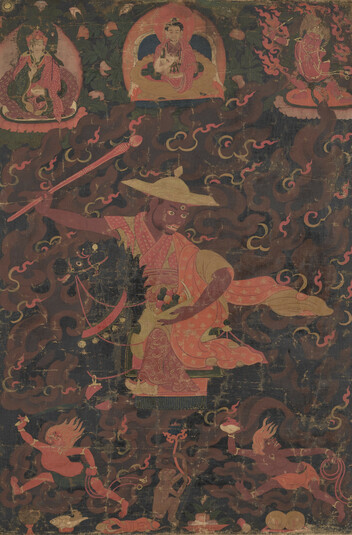
Item: Worldly Protector (Buddhist) - Dorje Shugden
| Origin Location | Tibet |
|---|---|
| Date Range | 1800 - 1899 |
| Lineages | Sakya and Buddhist |
| Material | Ground Mineral Pigment on Cotton |
| Collection | Private |
Classification: Deity
Appearance: Wrathful
Gender: Male
Dorje Shugden Dragpo Tsal Riding a Black Horse (English: the Vajra Possessing Strength).
Dorje Shugden is generally believed to be a Tibetan Buddhist worldly protector deity. He first appears in the Sakya Tradition. The earliest known ritual text was written by Morchen Kunga Lhundrub (1654-1728). According to some accounts Dorje Shugden was inducted into the pantheon of Sakya protectors by Sakya Trizin Sonam Rinchen (1705-1741). Later, placed together with the two protector deities Dorje Setrab and Tsi'u Marpo they were collectively known as the Three Kings (Gyalpo Sum). In the Sakya texts Shugden is known as Dorje Shugden Dragpo Tsal, or Dorje Shugden Riding a Black Horse. He typically holds a butcher's stick upraised in the right hand and a heart in the left raised to the mouth. Dressed in the robes of a monastic and wearing a gold lacquer riding hat, he sits atop a black horse. In the early 20th century Dorje Shugden Tanag fell out of favour with the Sakya Tradition and the ritual practices have been discouraged. His devotees and and accompanying ritual practices, oracles, and dances have subsequently diminished. Since the late 20th century the offering rituals for the Three Kings in general are no longer found in the standard daily use Sakya Protectors manuals employed in monasteries across India, Nepal or Tibet.
Dorje Shugden Dragpo Tsal has one face and two arms. He is maroon in colour, slightly fierce with three round red eyes and bared eye-teeth, disheveled and unshaven. Atop the head is a yellow hat of Chinese style worn by Buddhist monks when riding a horse or any beasts of burden. Attired in the bright orange and red garments, he has the appearance of a fully ordained Buddhist monk. In the upraised right hand is a red staff tipped with a jewel. In the left hand held to the side is a bowl of multi-coloured wish-fulfilling jewels and white pointed elephant tusks. The finger nails are long and curved like claws or talons. Dragpo Tsal sits astride a black horse suitably equipped with bridle, reins and saddle, bells and a large red tassel. The two figures are completely surrounded by swirling brown smoke and licks of orange flames.
'In the middle of a whirling palace of black wind ... is the Great King with a body red-black in colour, one face two arms. The right [hand] holds a club aloft to the sky and the left a skullcup filled with blood and a human heart. On the head a Chinese hat is placed, riding a black horse, surrounded by inconceivable emanations.' (Sakya Kangso).
In the lower composition are two raksha attendant figures in dynamic motion along with a seated brown monkey holding upraised a pot of some such substance.
At the top center is Drogon Wangdu Nyingpo (c.1763-c.1806), patriarch of the Khon Family, the 32nd Sakya Tridzin. At the left side is Padmasambhava in his most recognizable form and posture. On the right side is the deity Hayagriva, red in colour, with one face and two hands, holding upraised a stick and crowned with a green horse head. It is also common to find Guru Dragpo in painted compositions of Wangdu Nyingpo or in close relationship as a secondary figures.
There are no visible inscriptions on the front of the composition. Wangdu Nyingpo is identified by facial characteristics and the cross-eyed stare, along with the white lower garment, long hair, earrings, rudraksha beads, and the green trimmed shirt common to paintings of the early 19th century. Padmasambhava and Hayagriva are identified by standard iconographic characteristics.
Dorje Shugden Tanag is more commonly found as a Secondary Figure in painted compositions and generally included in a unique group of Sakya tradition protectors called the Three Kings.
There are at least three compositions which also depict the image of Wangdu Nyingpo, the second Padmasambhava of this Age and a renowned Terton (finder of Revealed Treasure).
There does not appear to be any inscriptions on the front or reverse of the painting. All identifications are based on iconographic characteristics and attributes. The composition is likely to be a single creation and does not have any indications that it belongs to a set or series of paintings. The painting style generally follows the tradition of a loose Lhasa Menri, also called New Menri, however the over-all appearance is not stylistically strong nor persuasive of a single painting school or tradition. The dating of the work to circa 1800 is based on the inclusion of the figure of Wangdu Nyingpo at the top center who religiously active until approximately 1806.
Jeff Watt 9-2022
Essay: Should I Buy Banned Art? (HAR on Patreon)
Videos: - Dorje Shugden - Worldly Protectors
Buddhist Deity: Dorje Shugden Masterworks
Collection: Christies New York Online, March, 2022 (Painting)
Buddhist Deity: Dorje Shugden Main Page
Buddhist Deity: Dorje Shugden (Tanag, Black Horse)
Collection: Christie's, March, 2022 (Curator's Selection, Painting)
